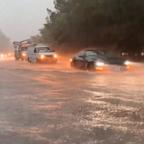Texan Officials 'Lean Into' Hurricane Demands
Texas officials say they're ready to deal with Hurricane Dolly aftermath.
July 23, 2008— -- Hurricane Dolly, recently downgraded to a Category 1 storm with sustained winds of 95 miles per hour, continued to pound the Texas coast while officials prepare for emergency and recovery operations.
Dolly slowed as its 15-mile-wide eye neared the Texas coast early this morning and has maintained its torrential, devastating winds and rain.
While coastal areas are in danger of flooding due to tides that are expected to be up to seven feet higher than normal, towns in the Rio Grand Valley are also in peril as unrelenting rainfall could topple protective levees.
Despite the dangers, in a press conference today Texas Gov. Rick Perry was optimistic about the state's ability to deal with the disaster.
"These hurricanes can be highly unpredictable. We prepare for the worst and pray for the best," he said. "This is Texas. Our approach is to lean into these problems."
Perry explained that the state's preparations "kicked into high gear" as early as Sunday afternoon when Dolly, then a tropical storm, was believed to be a threat and resources were placed where the storm was expected to come ashore.
Perry issued disaster declarations for 14 counties in southern Texas. In response, the state has established 17 local shelters that currently house nearly 3,000 people.
Despite Perry's insistence that in Texas officials "believe in local control of these emergency situations," the Federal Emergency Management Agency held a press conference today along with several organizational partners to outline their own disaster preparations.
Over 1,000 National Guard troops have been activated in the area as a precaution for levee breaches in the Rio Grande Valley. The Army Corps of Engineers and the U.S. Coast Guard have been in contact with their counterparts in Mexico to streamline possible cooperative emergency actions, according to officials at a press conference.
Rainfall expectations, which have lowered from as high as 15 inches to around 10 inches, according to FEMA Deputy Administrator Harvey Johnson, still pose a serious threat to the levees.




